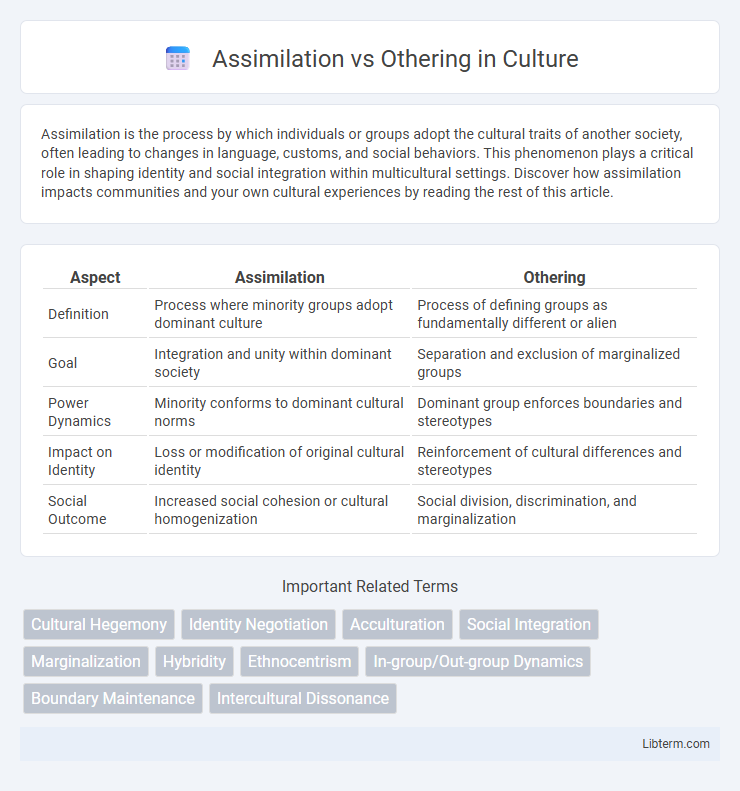Assimilation is the process by which individuals or groups adopt the cultural traits of another society, often leading to changes in language, customs, and social behaviors. This phenomenon plays a critical role in shaping identity and social integration within multicultural settings. Discover how assimilation impacts communities and your own cultural experiences by reading the rest of this article.
Table of Comparison
| Aspect | Assimilation | Othering |
|---|---|---|
| Definition | Process where minority groups adopt dominant culture | Process of defining groups as fundamentally different or alien |
| Goal | Integration and unity within dominant society | Separation and exclusion of marginalized groups |
| Power Dynamics | Minority conforms to dominant cultural norms | Dominant group enforces boundaries and stereotypes |
| Impact on Identity | Loss or modification of original cultural identity | Reinforcement of cultural differences and stereotypes |
| Social Outcome | Increased social cohesion or cultural homogenization | Social division, discrimination, and marginalization |
Understanding Assimilation: Definition and Context
Assimilation refers to the process by which individuals or groups adopt the cultural norms, values, and behaviors of a dominant society, often leading to the diminishing of their original cultural identity. This concept is commonly studied in sociology and anthropology, highlighting how immigrant populations integrate into a host culture through language acquisition, social norms adaptation, and economic participation. Understanding assimilation involves recognizing its impact on both the assimilating group's identity and the broader societal dynamics of inclusion and exclusion.
The Concept of Othering in Society
Othering in society refers to the process by which certain groups or individuals are marginalized by being labeled as fundamentally different or alien. This social mechanism reinforces power dynamics and creates divisions that exclude unlike identities from mainstream cultural or social norms. The concept highlights how stereotypes and prejudice contribute to systemic discrimination and social exclusion.
Historical Perspectives on Assimilation
Historical perspectives on assimilation reveal its role as a state-driven strategy aimed at integrating minority groups into dominant cultural norms, often at the expense of erasing indigenous identities and languages. Colonial powers and nation-states used assimilation policies to enforce cultural homogeneity, targeting immigrant populations and indigenous peoples through education, legal systems, and social institutions. These practices contributed to significant social and cultural displacement, highlighting tensions between cultural preservation and enforced conformity.
Mechanisms and Processes of Othering
Mechanisms and processes of othering involve categorizing individuals or groups as fundamentally different, often through stereotyping, exclusion, and dehumanization, which reinforces social hierarchies. Othering operates by establishing boundaries that separate "us" from "them," leading to marginalization and discrimination in societal, cultural, and institutional contexts. These processes are sustained through language, media representation, and systemic power structures that entrench inequality and social division.
Assimilation vs Othering: Key Differences
Assimilation involves the process by which minority groups adopt the cultural norms of a dominant society, leading to integration and often the loss of original cultural identity. Othering, in contrast, is the act of perceiving or portraying a group as fundamentally different or alien, resulting in social exclusion and marginalization. Key differences include assimilation's emphasis on blending and conformity, while othering emphasizes division and separation based on perceived differences.
Social Identity and Cultural Integration
Assimilation involves adopting the dominant culture's norms and values, often resulting in diminished minority social identities, while othering reinforces exclusion by marking certain groups as fundamentally different. Social identity theory highlights how individuals seek belonging through group affiliation, which assimilation pressures can disrupt, causing identity conflict. Effective cultural integration balances preserving distinct social identities with fostering inclusive participation in the broader society.
Impact on Minority Communities
Assimilation often pressures minority communities to abandon distinct cultural identities, leading to loss of heritage and diminished social cohesion within those groups. Othering reinforces social exclusion by marginalizing minorities, fostering discrimination, and limiting access to resources and opportunities. Both processes significantly shape the psychological well-being, economic mobility, and political representation of minority populations.
Psychological Effects of Assimilation and Othering
Assimilation often leads to identity erosion and emotional distress as individuals suppress cultural traits to conform, causing internal conflicts and reduced self-esteem. Othering results in social exclusion, stigma, and psychological trauma, fostering feelings of alienation and chronic stress among marginalized groups. Both processes significantly impact mental health, influencing anxiety, depression, and overall well-being within affected populations.
Policy Implications and Social Inclusion
Assimilation policies often emphasize the adoption of dominant cultural norms, potentially marginalizing minority identities and hindering social inclusion by promoting conformity rather than diversity. In contrast, multicultural policies encourage recognition and respect of different cultural backgrounds, fostering social cohesion and equitable participation in societal institutions. Effective policy frameworks must balance integration with cultural recognition to reduce social exclusion and support inclusive community development.
Navigating Between Belonging and Exclusion
Assimilation involves adopting the cultural norms of a dominant group, often leading to a sense of belonging but risking the erasure of original identities. Othering, on the contrary, emphasizes differences and exclusion, reinforcing social divisions and marginalization. Navigating between belonging and exclusion requires balancing integration efforts while preserving cultural distinctiveness to foster inclusive communities.
Assimilation Infographic

 libterm.com
libterm.com